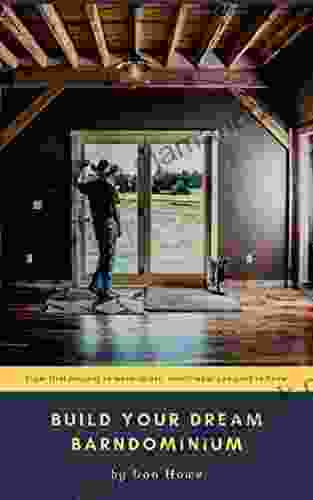From First Concept To Move In Day: Here's What You Need To Know

Building a house is a major undertaking, but it can be a rewarding experience. With careful planning and execution, you can create a home that is both beautiful and functional, and that meets your specific needs and desires.
4.1 out of 5
| Language | : | English |
| File size | : | 6787 KB |
| Text-to-Speech | : | Enabled |
| Screen Reader | : | Supported |
| Enhanced typesetting | : | Enabled |
| X-Ray | : | Enabled |
| Print length | : | 120 pages |
| Lending | : | Enabled |
Here's a comprehensive guide to help you from the first concept to move-in day:
1. Planning
The first step in building a house is planning. This involves developing a clear vision for your home, including its size, layout, and style. You'll also need to create a budget and timeline for your project.
Here are some things to consider during the planning phase:
- Your needs and wants: What are the most important features of your new home? How many bedrooms and bathrooms do you need? What kind of layout do you prefer?
- Your budget: How much can you afford to spend on your new home? Keep in mind that the cost of building a house can vary depending on a number of factors, including the size, style, and location of your home.
- Your timeline: How long do you have to build your new home? A realistic timeline will help you stay on track and avoid delays.
2. Design
Once you have a clear plan in place, you can begin designing your home. This is a fun and creative process, but it's also important to be realistic and to make sure that your design meets your needs and budget.
Here are some things to consider during the design phase:
- The style of your home: What architectural style do you prefer? Traditional, modern, or something in between?
- The layout of your home: How do you want the different rooms in your home to flow together?
- The materials you want to use: What materials will you use for the exterior and interior of your home?
3. Budget
As mentioned above, it's important to create a realistic budget for your new home. This will help you make informed decisions about the size, style, and materials of your home.
Here are some tips for creating a budget:
- Get quotes from multiple contractors: This will help you get a good idea of the cost of building your home.
- Factor in the cost of land: If you don't already own land, you'll need to factor in the cost of purchasing a lot.
- Be realistic about your expectations: It's important to be realistic about what you can afford. Don't overextend yourself financially.
4. Timeline
Once you have a budget in place, you can create a timeline for your project. This will help you stay on track and avoid delays.
Here are some things to consider when creating a timeline:
- The size and complexity of your home: The larger and more complex your home is, the longer it will take to build.
- The availability of contractors: Make sure to factor in the availability of contractors when creating your timeline.
- The weather: If you're building in a climate with extreme weather, you may need to adjust your timeline accordingly.
5. Contractors
Once you have a design and budget in place, you can start hiring contractors. It's important to choose qualified contractors who have experience building homes.
Here are some tips for hiring contractors:
- Get referrals from friends and family: This is a great way to find qualified contractors who have a good reputation.
- Check online reviews: You can also check online reviews to see what other people have said about potential contractors.
- Get multiple quotes: This will help you get the best possible price for your project.
6. Permits
Before you can start building your home, you'll need to obtain the necessary permits. This typically involves submitting plans for your home to the local building department.
The building department will review your plans to make sure that they meet all of the applicable building codes. Once your plans are approved, you will be issued a building permit.
7. Inspections
During the construction process, your home will be inspected by the local building department. These inspections are to ensure that your home is being built according to code.
There are typically several inspections that are required during the construction process, including:
- Foundation inspection: This inspection ensures that the foundation of your home is sound and properly built.
- Framing inspection: This inspection ensures that the framing of your home is properly constructed.
- Electrical inspection: This inspection ensures that the electrical system in your home is safe and properly installed.
- Plumbing inspection: This inspection ensures that the plumbing system in your home is safe and properly installed.
8. Move-in day
Once your home is complete, it's time to move in! This is an exciting day, but it's also important to be prepared.
Here are some things to do before you move in:
- Clean your home: Make sure to clean your home thoroughly before you move in. This will help you remove any dust or debris that may have accumulated during the construction process.
- Set up your utilities: Make sure to set up your utilities, such as electricity, gas, and water, before you move in.
- Unpack your belongings: Start unpacking your belongings and putting your home in order. This will help you feel more settled in your new home.
Building a house is a major undertaking, but it can be a rewarding experience. By following these steps, you can create a home that is both beautiful and functional, and that meets your specific needs and desires.
4.1 out of 5
| Language | : | English |
| File size | : | 6787 KB |
| Text-to-Speech | : | Enabled |
| Screen Reader | : | Supported |
| Enhanced typesetting | : | Enabled |
| X-Ray | : | Enabled |
| Print length | : | 120 pages |
| Lending | : | Enabled |
Do you want to contribute by writing guest posts on this blog?
Please contact us and send us a resume of previous articles that you have written.
 Top Book
Top Book Novel
Novel Fiction
Fiction Nonfiction
Nonfiction Literature
Literature Paperback
Paperback Hardcover
Hardcover E-book
E-book Audiobook
Audiobook Bestseller
Bestseller Classic
Classic Mystery
Mystery Thriller
Thriller Romance
Romance Fantasy
Fantasy Science Fiction
Science Fiction Biography
Biography Memoir
Memoir Autobiography
Autobiography Poetry
Poetry Drama
Drama Historical Fiction
Historical Fiction Self-help
Self-help Young Adult
Young Adult Childrens Books
Childrens Books Graphic Novel
Graphic Novel Anthology
Anthology Series
Series Encyclopedia
Encyclopedia Reference
Reference Guidebook
Guidebook Textbook
Textbook Workbook
Workbook Journal
Journal Diary
Diary Manuscript
Manuscript Folio
Folio Pulp Fiction
Pulp Fiction Short Stories
Short Stories Fairy Tales
Fairy Tales Fables
Fables Mythology
Mythology Philosophy
Philosophy Religion
Religion Spirituality
Spirituality Essays
Essays Critique
Critique Commentary
Commentary Glossary
Glossary Bibliography
Bibliography Index
Index Table of Contents
Table of Contents Preface
Preface Introduction
Introduction Foreword
Foreword Afterword
Afterword Appendices
Appendices Annotations
Annotations Footnotes
Footnotes Epilogue
Epilogue Prologue
Prologue Kg Stiles
Kg Stiles Joyce Dipastena
Joyce Dipastena Zack Bowman
Zack Bowman Richard Panek
Richard Panek Guy Davenport
Guy DavenportM E
 Dan Dana
Dan Dana Peter J D Adamo
Peter J D Adamo Maria Wheeler
Maria Wheeler Debbie Miller
Debbie Miller Alaric Bond
Alaric Bond Taylor Anderson
Taylor Anderson T E Hulme
T E Hulme Daniel O Malley
Daniel O Malley Ulysses S Grant
Ulysses S Grant Heather Horrocks
Heather Horrocks Gulmakai Saleh
Gulmakai Saleh Rich Murphy
Rich Murphy Denise Weldon Siviy
Denise Weldon Siviy Helen M King
Helen M King
Light bulbAdvertise smarter! Our strategic ad space ensures maximum exposure. Reserve your spot today!

 Deion SimmonsThe Flames of Hope: Wings of Fire 15 - A Captivating Journey of Determination...
Deion SimmonsThe Flames of Hope: Wings of Fire 15 - A Captivating Journey of Determination... Jorge Luis BorgesFollow ·19.5k
Jorge Luis BorgesFollow ·19.5k Julio CortázarFollow ·15k
Julio CortázarFollow ·15k Aleksandr PushkinFollow ·4.4k
Aleksandr PushkinFollow ·4.4k Ethan MitchellFollow ·13.6k
Ethan MitchellFollow ·13.6k Todd TurnerFollow ·5.3k
Todd TurnerFollow ·5.3k Richard WrightFollow ·17.6k
Richard WrightFollow ·17.6k Jacques BellFollow ·2k
Jacques BellFollow ·2k Tom ClancyFollow ·5.9k
Tom ClancyFollow ·5.9k

 Jaylen Mitchell
Jaylen MitchellPretime Piano Jazz Blues Primer Level: A Comprehensive...
The Pretime Piano...

 Mark Twain
Mark TwainSurviving and Thriving with the Self-Absorbed: A...
Interacting with self-absorbed...

 John Keats
John KeatsTo Love Is To Surrender: A Deep Dive into the...
Surrender is one of the most enigmatic and...

 Steven Hayes
Steven HayesRich Murphy: A Visionary Engineer Shaping the Future of...
In the annals of space...

 Neil Parker
Neil ParkerProper Love: Navigating the Hardships of the Heart
Love is a beautiful emotion that can bring...
4.1 out of 5
| Language | : | English |
| File size | : | 6787 KB |
| Text-to-Speech | : | Enabled |
| Screen Reader | : | Supported |
| Enhanced typesetting | : | Enabled |
| X-Ray | : | Enabled |
| Print length | : | 120 pages |
| Lending | : | Enabled |












